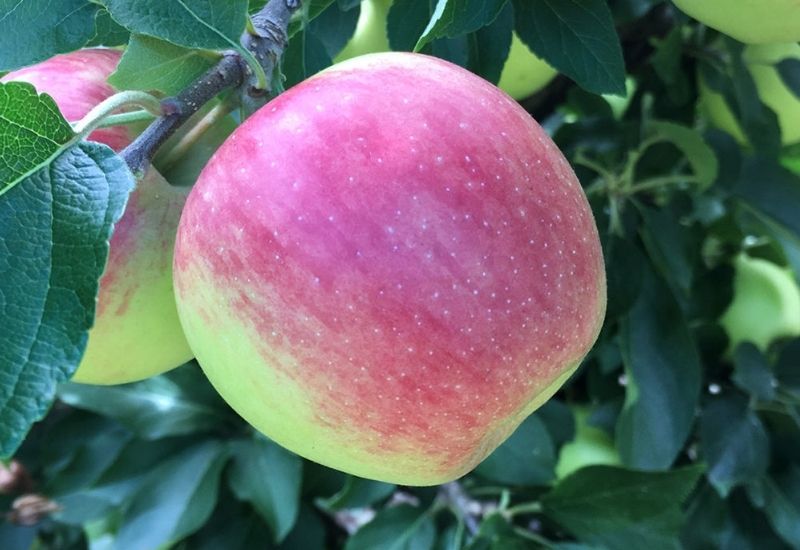Ambrosia apples are a versatile apple with a sweet flavor that works well in both fresh and cooked dishes. The apples have thin skin, which is best to keep on to get the most nutrients.
Ambrosia apples can be eaten as is, chilled for better taste, or sliced and used in various dishes like charcuterie plates, slaws, salads, or as a topping for breakfast foods like pancakes, oats, porridge, or parfaits.
They can also be juiced or blended into smoothies. The flesh of Ambrosia apples doesn’t brown quickly, making them great for sandwiches or school lunches.
In addition to fresh uses, you can roast them with root vegetables, scramble them, use them in stuffing or soups, cook them into risotto, polenta, or couscous, make applesauce or popsicles with them, or poach and serve them with sorbet.
Ambrosia apples hold their shape when cooked, making them perfect for cakes, pies, muffins, doughnuts, fritters, or stuffing them with dried fruits and nuts for a savory-sweet dessert.
They’re naturally sweet, so you need less sugar in desserts. Ambrosia apples go well with cheeses like brie, cheddar, parmesan, figs, lavender, kale, squash, pork, poultry, beef, seafood, vanilla, caramel, sesame, and brown sugar.
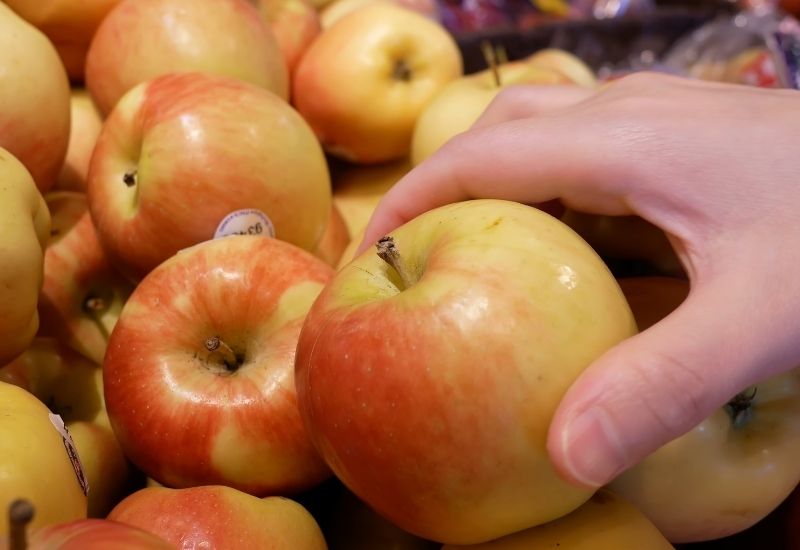
Nutritional value of Ambrosia apples
| Nutrient | Amount | % Daily Value |
|---|---|---|
| Serving Size | Medium (3″ dia) (182g) | – |
| Calories | 95 kcal | – |
| Total Fat | 0.3g | 0% |
| – Saturated Fat | 0.1g | 0% |
| – Trans Fat | 0g | – |
| – Polyunsaturated Fat | 0.1g | – |
| – Monounsaturated Fat | 0g | – |
| Cholesterol | 0mg | 0% |
| Sodium | 1.8mg | 0% |
| Total Carbohydrates | 25g | 9% |
| – Dietary Fiber | 4.4g | 16% |
| – Sugars | 19g | – |
| Protein | 0.5g | – |
| Vitamin D | 0mcg | 0% |
| Calcium | 11mg | 1% |
| Iron | 0.2mg | 1% |
| Potassium | 194.7mg | 4% |
| Caffeine | 0mg | – |
What is unique about ambrosia apples?
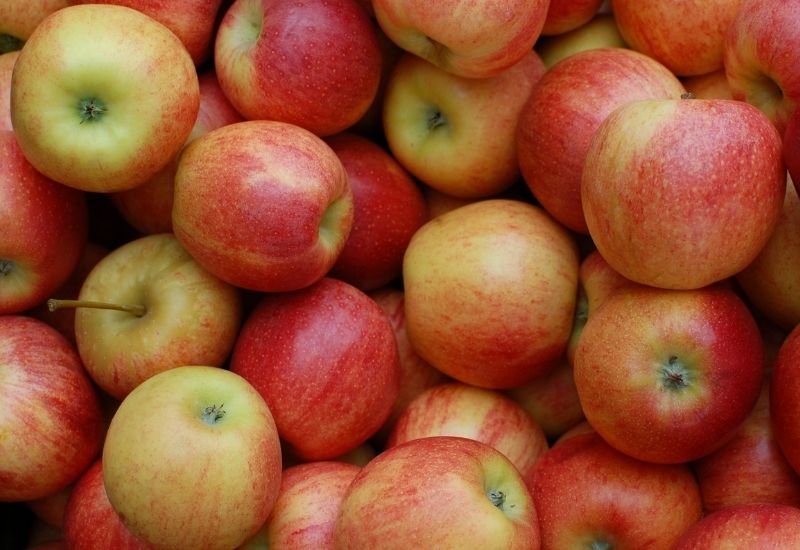
The taste of Ambrosia is often described as invigorating, featuring floral undertones and a delightfully crisp texture. It’s notably sweet, with minimal acidity.
One of the unique aspects of the Ambrosia apple is its natural resistance to browning soon after slicing, making it an excellent choice for snacks or salads. It’s also suitable for cooking!
Where does the Ambrosia apple grow?
Although Ambrosia apples have their roots in Canada, they are now cultivated on farms globally, including places like Chile, New Zealand, Australia, Italy, and the United States.
In fact, if you find yourself savoring an Ambrosia apple in early September in Canada, it was likely cultivated in the Southern Hemisphere.
Are ambrosia apples a good eating apple?

Ever since an apple picker took a bite of an unnamed apple in a Cawston Orchard, Ambrosia apples have won over hearts and taste buds. But why do people love this apple so much?
Science and psychology provide the answers.
Pretty is Important
Ambrosia apples not only taste great but also look appealing. A study conducted at the Niederrhein University of Applied Sciences in Germany found that consumers prefer bi-colored apples, like Ambrosia, associated with sweetness, freshness, juiciness, and naturalness. So, if you’re drawn to Torosia apple’s yellow and red colors, you’re not alone.
Slower to Brown
People need help finding an apple slice appealing. Ambrosia apples are a favorite – they are slow to brown, making them stay fresh-looking even after cutting. Parents love them because they can prepare them for their children’s snacks without worrying about them turning.
Teeth-Pleasing
Ambrosia apples have a thinner skin, making them easy to bite into. Whether you haveures or brand new teeth, Ambros apples are a better choice. The lighter skin also enhances the eating experience for everyone else.
Crunchy SatisfactionThe firm and crunchy flesh of Ambrosia apples provide a satisfying crunch. Eating crunchy foods can help keep you calm and focused, as recommended by occupational therapists.
Versatile
Unlike traditional categories, Ambrosia apples can be enjoyed both raw and cooked. They are delicious when eaten raw and bake beautifully in various dishes.
Award-Winning Taste
Ambrosia apples have been recognized as the best by the public and experts. They were crowned the Grand Champion of New Apple Varieties at the Royal Agricultural Winter Fair in Toronto in 2017 and 2018. Additionally, Ambrosia apples have been a top-selling variety for the past 5 years.
If you love Ambrosia apples, you’re not alone. Now, you have many reasons to defend your claim that they are the best apples.
What apples make Ambrosia?
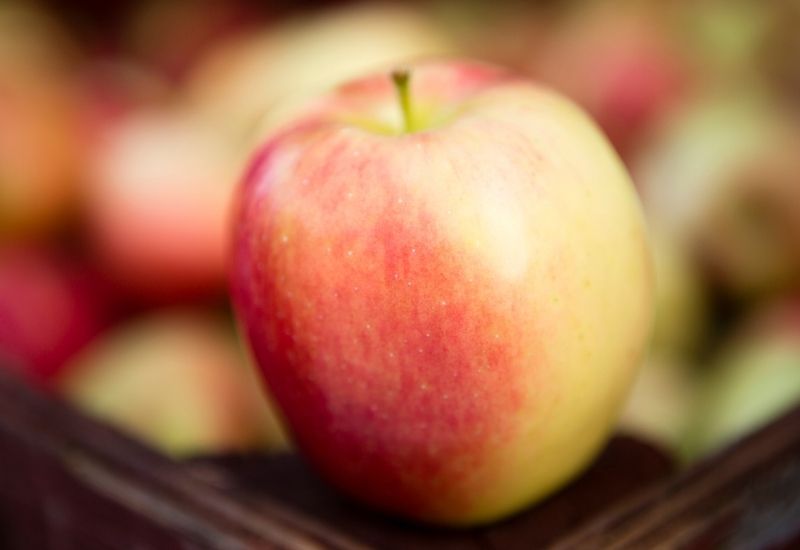
Discovered as an unexpected seedling in Wilfrid and Sally Mennell’s orchard in Cawston, British Columbia, during the late 1980s to early 1990s, Ambrosia apples quickly drew attention for their exceptional flavor and color.
The Mennell family nurtured this seedling into a mature apple tree and, recognizing its unique qualities, partnered with the Summerland Varieties Corporation (formerly Pico or the Okanagan Plant Improvement Corporation) in 1993 to register this new variety.
While the exact lineage of Ambrosia apples remains uncertain, pomologists suggest Jonagold and Golden Delicious as potential parents due to the proximity of these cultivars.
Following their introduction in the 1990s, Ambrosia apples were distributed to growers worldwide under stringent production rules.
The variety was patented throughout the 1990s and early 2000s, providing exclusive rights to specific orchards and demanding fees from others.
This patent expired in Canada in 2015 and the United States in 2017, with Chile expected to follow in 2021. However, many other countries will maintain the patent until 2034.
Today, Ambrosia apples continue to be cultivated in their place of origin, Cawston, British Columbia, with the original Ambrosia tree still alive and bearing fruit.
Beyond Canada, they are also grown in regions across the United States, South America, Australia, New Zealand, and Europe. They are available at farm stands, through distributors, and in select grocery stores.
What does a ripe Ambrosia apple look like?
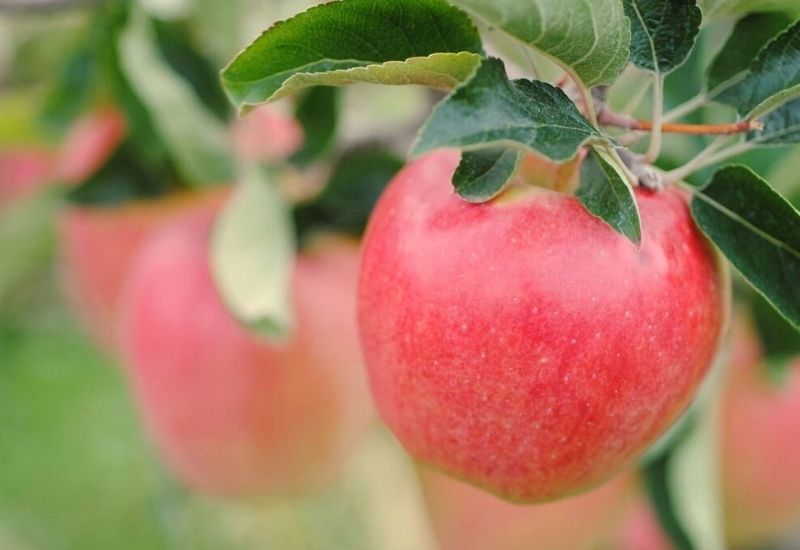
This appealing, mid-sized apple boasts high-gloss skin, showcasing a 70% to 90% vibrant red blush adorned with subtle, broad stripes against a cream-to-yellow backdrop.
When perfectly ripe, the Ambrosia apple exudes floral undertones akin to wildflower honey. Remarkably low in acidity, these apples offer no tart or tangy flavors, only a mellow sweetness.
The Ambrosia apple tree is compact, growing uprightly and proving highly fruitful, producing moderate to heavy yearly yields.
How do you identify Ambrosia apples?
The Ambrosia apple is truly a feast for the senses, deeply cherished by the Davison family. Its delightful sweetness and pleasant flavor make it an irresistible treat, while its crisp texture holds a gentler crunch than that of a Golden Delicious.
Being a low-acidic fruit, the Ambrosia apple is easily digestible, making it an ideal snack for children and older people. You can recognize this medium-sized apple by its distinctive red blush against a yellow background.
What is the difference between Gala and Ambrosia apples?
| Apple Variety | Taste | Texture | Qualities |
|---|---|---|---|
| Ambrosia | Sweet | Low acidity | Known as “food of the gods” due to its sweetness and low acidity |
| Braeburn | Sweet-tart | Firm, Juicy | Excites every taste bud, not just sweet |
| Gala | Sweet | Crisp | Great for everyday snacking |
| Fuji | Very Sweet | Crisp, Firm, Juicy | Eating a Fuji is like eating candy |
| Honeycrisp | Sweet-tart | Juicy | Great for snacking, offers a more interesting experience due to its sweet and tart flavor |
Do ambrosia apples ripen after picking?
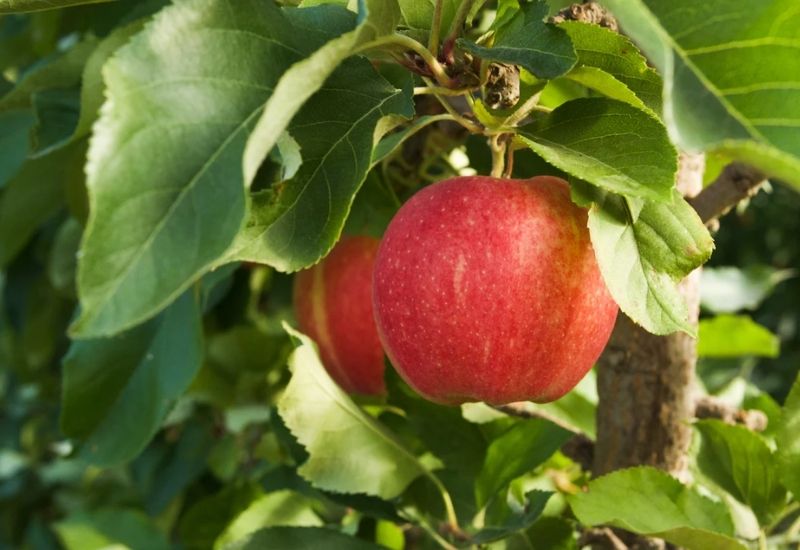
To achieve optimal results, procure local Ambrosia apples and store them right after picking. Remember, apples mature faster in warmer conditions; thus, the perfect storage temperature is between 0-2°C to decelerate the ripening and softening process.
An interesting fact is that apples mature twice as quickly at 4°C than at 0°C, and almost double that rate at 10°C compared to 4°C! Take note that apples can freeze at about -2°C. As you can see, there’s a narrow margin for error!
Moreover, it’s crucial to keep a humidity level of 90-95%.
How long do Ambrosia apples last?
Ambrosia apple orchards require meticulous supervision weeks before the harvest due to their notably brief harvesting window among commercial apple varieties.
Ensuring they are picked at the perfect moment and appropriately handled and stored will keep them fresh and tasty even after half a year in storage.
Do ambrosia apples turn brown?
One of the things people know about Ambrosia apples is that they don’t brown quickly after being cut. This is great for preparing apple slices in advance, such as for kids’ snacks.
So, you might wonder why Ambrosia apples brown slower than other apples if they’re all-natural.
To simplify the scientific explanation, all apples contain phenolic compounds that react to air. When exposed to oxygen, polyphenol oxidase enzymes in the apples start to change into new enzymes that have a brownish color. The longer these enzymes are exposed, the browner they become. All natural apples contain polyphenol oxidase (PPO).
Now, let’s answer our original question: why don’t Ambrosia apples brown as fast as other apples?
The speed at which apples brown primarily depends on the amount of PPO they have. Ambrosia apples have a lower level of this enzyme. So, when an Ambrosia apple is cut, and to oxygen, it starts to brown, but at a slower. Because there is less enzyme to react with the air, the oxidation process takes longer.
Many people know that squeezing lemon over apple slices helps slow down browning. This is because lemons have a low pH level, which slows down the polyphenol oxidase process. However, this is not necessary with Ambrosia apples! As we mentioned, Ambrosia apples already have less active polyphenol oxidase, and adding lemon will only mask their honey-sweet flavor.
Should Ambrosia apples be refrigerated?
The ideal storage temperature for Ambrosia apples is between 32° and 40°F. It’s suggested that you keep them towards the front of your refrigerator, close to the door. This is because the temperature varies from the show to the back of the fridge, influenced by the position of the cooling system and how often the door is opened.
How do you keep ambrosia apples fresh?
At this time of year, Ambrosia Apple fans worry about when the supply will run out. Ambrosia apples are usually harvested in late September in North America, so we’re approaching the six-month mark. So, how much longer can the Ambrosia apple supply last?
No need to panic! After being picked, Ambrosia apples are taken to a packinghouse and prepared for storage in a controlled atmosphere facility. This facility ensures optimal levels of oxygen, carbon dioxide, nitrogen, temperature, and humidity, which can keep the apples fresh for up to a year.
Keeping your Ambrosia apples fresh at home is up to you. Since you can’t create a controlled atmosphere storage room in your basement, here are three tips for keeping your Ambrosia apples crisp and juicy:
1 – Wrap them up: To prevent one rotting apple from spoiling the rest, individually wrap each apple in brown paper or newspaper. Writing is better than plastic because it allows the apples to breathe.
2 – Keep them cold: Store your apples in a hard place like a basement or refrigerator. Just be careful not to store them in an uninsulated shed or garage if temperatures drop below freezing. You want cold apples, not frozen ones.
3 – Eat them up: The best way to keep your Ambrosia apples fresh is to consume them quickly. Buying them more frequently ensures that you’re getting the freshest apples. Stores remove apples from controlled atmosphere storage as demanded, so the ones you buy this week were likely stored until recently.
Following these steps, you should have fresh Ambrosia apples for a few more months until supplies run out. Then, the countdown to September begins!
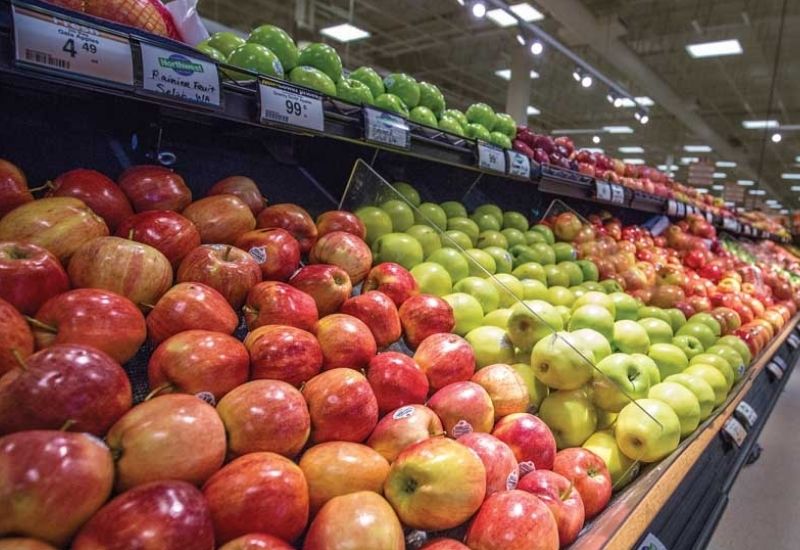
Enjoy the Natural Taste with Farm to Palm Supermarket!
We know you love freshness, health, and convenience. Therefore, come to Farm to Palm supermarket to enjoy the highest quality, delicious apples! Our apples are carefully nurtured and handpicked from lush apple orchards, offering an irresistible, fresh, sweet taste.
Not only providing delicious fresh apples, Farm to Palm also brings you top-notch convenience. You can visit our supermarket to choose directly or download the Farm to Palm app from the App Store and order your favorite apples. All products will be delivered to your doorstep quickly and conveniently.
Explore the fresh, nutritious taste of the highest quality apples with Farm to Palm. Don’t hesitate to shop today for an excellent shopping experience with Farm to Palm!

